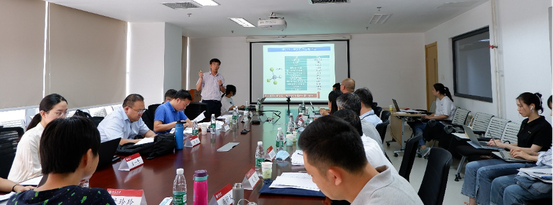Project Finds Huge Potential of HFC-23 Mitigation in China
In August 2021, the College of Environmental Sciences and Engineering of Peking University and the Foreign Environmental Cooperation Center (FECO), a think tank overseen by China’s Ministry of Ecology and Environment (MEE), held a workshop reviewing their hydrofluorocarbon (HFC)-23 project supported by Energy Foundation China (EF China). Attendees included the nine review experts led by Professor Chunxi LI of Beijing University of Chemical Technology, officials from MEE’s Department of Atmospheric Environment, members of EF China’s Environmental Management Program, and the project team.

Prof. Jianxin HU presents the research findings
Photo by the College of Environmental Sciences and Engineering of Peking University
Professor Jianxin HU of Peking University said that the project team examined 20 running HCFC-22 enterprises—out of the total 21 registered enterprises in China, one of which under construction—across the country via correspondence, and visited and conducted thorough investigation on companies including Dongyue Group of Shandong Province and Zhonghao Chenguang Research Institute of Chemical Industry of Sichuan Province, before they produced four research outputs: historical emission levels and disposal practices of HFC-23, analysis of HFC-23 emission mitigation gaps, assessment on necessary management policies and measures, and cost-benefit analysis of HFC-23 emission mitigation strategies. The project team also came up with suggestions for systematic HFC-23 emission mitigation. If well implemented, China could reduce HFC-23 emissions by 12 billion tonnes of CO2 equivalent by 2060, and with suitable technology , the mitigation would bring about economic benefits as well, said Prof. Hu.

Chief Expert Kaixiang WANG present the research findings
Photo by the College of Environmental Sciences and Engineering of Peking University
Chief Expert Kaixiang WANG from FECO analyzed the current practices of HFC-23 emission reporting in China and the mitigation targets required by the Kigali Amendment, before he proposed how China should cut its HFC-23 emissions, including formulating mandatory mitigation regulations and technical guidelines, supporting R&D and market utilization of HFC-23 waste, and establishing a monitoring, reporting, and verification system.

Xin LIU, Director of the Environment Management Program, EF China
Photo by the College of Environmental Sciences and Engineering of Peking University
Experts agreed that after the Kigali Amendment took effect in China as of September 15, it was a pressing task to deploy HFC-23 emission reduction. The Ministry of Ecology and Environment released its Notice on Controlling HFC-23 Byproduct Emissions on September 14. Findings of this project would offer scientific analysis for China’s future HFC-23 mitigation actions under the amendment.




